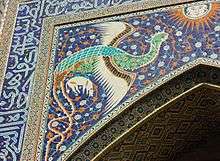Huma bird
The Huma (Persian: هما, pronounced Homā, Avestan: Homāio), also Homa, is a mythical bird of Iranian legends and fables,[2][3] and continuing as a common motif in Sufi and Diwan poetry. Although there are many legends of the creature, common to all is that the bird is said to never alight on the ground, and instead to live its entire life flying invisibly high above the earth.
Onomastics
New Persian Homa derives from Avestan Homāio.[4] In several dialects of the Persian language, the name 'Homa' is additionally applied to the Bearded vulture (lammergeier).
There are numerous folk interpretations of the name, among them that of the Sufi teacher Inayat Khan, who supposed that "in the word Huma, hu represents spirit, and the word mah originates from the Arabic 'Maʼa' ماء which means water."[5]
Myths and legends
The Huma bird is said to never come to rest, living its entire life flying invisibly high above the earth, and never alighting on the ground (in some legends it is said to have no legs).[6]

In several variations of the Huma myths, the bird is said to be phoenix-like, consuming itself in fire every few hundred years, only to rise anew from the ashes. The Huma bird is said to have both the male and female natures in one body, each nature having one wing and one leg. Huma is considered to be compassionate, and a 'bird of fortune'[7] since its shadow (or touch) is said to be auspicious.
In Sufi tradition, catching the Huma is beyond even the wildest imagination, but catching a glimpse of it or even a shadow of it is sure to make one happy for the rest of his/her life. It is also believed that Huma cannot be caught alive, and the person killing a Huma will die in forty days.[7]
In Ottoman poetry, the creature is often referred to as a 'bird of paradise',[7][8] and early European descriptions of the Paradisaeidae species portrayed the birds as having no wings or legs, and the birds were assumed to stay aloft their entire lives.
In Attar of Nishapur's allegorical masterpiece The Conference of the Birds, an eminent example of Sufi works in Persian literature, the Huma bird is portrayed as a pupil that refuses to undertake a journey because such an undertaking would compromise the privilege of bestowing kingship on those whom it flew over. In Iranian literature, this kingship-bestowing function of the Huma bird is identified with pre-Islamic monarchs, and stands vis-a-vis ravens, which is a metaphor for Arabs.[9] The legend appears in non-Sufi art as well.[10]
The kingship-bestowing function of the Huma bird reappear in Indian stories of the Mughal era, in which the shadow (or the alighting) of the Huma bird on a person's head or shoulder were said to bestow (or foretell) kingship. Accordingly, the feathers decorating the turbans of kings were said to be plumage of the Huma bird.[11]
Sufi teacher Inayat Khan gives the bestowed-kingship legend a spiritual dimension: "Its true meaning is that when a person's thoughts so evolve that they break all limitation, then he becomes as a king. It is the limitation of language that it can only describe the Most High as something like a king."[5]
The Huma bird symbolizes unreachable highness in Turkish folk literature.[12] Some references to the creature also appear in Sindhi literature, where – as in the diwan tradition – the creature is portrayed as bringing great fortune. In the Zafarnama of Guru Gobind Singh, a letter addressed to Mughal Emperor Aurangzeb refers to the Huma bird as a "mighty and auspicious bird".
Legacy
A British Museum catalog captions a photograph of the griffin-like capitals at Persepolis with "Column capital in the form of griffins (locally known as 'homa birds')".[1] The Persian language acronym for "Iran National Airline" is HOMA and the airline's emblem is the stylized rendering of a Persepolis capital.
Herman Melville briefly alludes to the bird in Moby-Dick. At the beginning of the chapter entitled "The Tail," the narrator speaks of "the bird that never alights."
It is also referred to in movie Days of Being Wild by Wong Kar-wai and the play "Orpheus Descending" by Tennessee Williams.
The literature series Dragonlance named Krynn's greatest hero, Huma Dragonbane, after the Huma bird.
See also
References
- 1 2 3 Curtis, John; Tallis, Nigel, eds. (2005), Forgotten Empire, the World of Ancient Persia, London: British Museum Press, ISBN 978-0-7141-1157-5
- ↑ MacKenzie, D. N. (2005), A concise Pahlavi Dictionary, London & New York: Routledge Curzon, ISBN 0-19-713559-5
- ↑ Mo'in, M. (1992), A Persian Dictionary. Six Volumes, Tehran: Amir Kabir Publications, ISBN 1-56859-031-8
- ↑ Doostkhah, Jalil (1991), Avesta – The Ancient Iranian Hymns & Texts, Tehran: Morvarid Publications, ISBN 964-6026-17-6
- 1 2 Khan, Inayat (1923), "Abstract Sound", The Mysticism of Music, Sound and Word, wahiduddin.net.
- ↑ Nile, Green (2006), "Ostrich Eggs and Peacock Feathers: Sacred Objects as Cultural Exchange between Christianity and Islam", Al Masaq: Islam and the Medieval Mediterranean, 18 (1): 27–78, doi:10.1080/09503110500222328.
- 1 2 3 H. Dilek Batîslam, Mythological Birds of the Classical Ottoman Poetry: Huma, Anka and Simurg. (PDF) (in Turkish), Türk Kültürü İncelemeleri Dergisi,İstanbul 2002, 185–208, retrieved 3 August 2009
- ↑ cf. Andrews, Walter; Kalpakli, Mehmet (2005), The Age of Beloveds, Duke University Press, pp. 341–342.
- ↑ Pourshariati, Parvaneh (2000), "Local Historiography in Early Medieval Iran and the Tārīkh-i Bayhaq", Iranian Studies, 33 (1/2): 133–164, doi:10.1080/00210860008701979, p. 151.
- ↑ cf. Goswamy, B. N. (1997), "Nainsukh of Guler: A Great Indian Painter from a Small Hill-State", Artibus Asiae, Supplementum, 41: 5–304, p. 118.
- ↑ Schimmel, Annemarie; Attwood, Corinne; Waghmar, Burzine (2004), The Empire of the Great Mughals: History, Art and Culture, Reaktion, p. 30.
- ↑ Erdoğan Altınkaynak, Yer Altı Diyarının Kartalı (in Turkish), Hacı Bektaş Veli Araştırma Dergisi, 26, 135 – 163 (2003), retrieved 8 March 2014


.png)